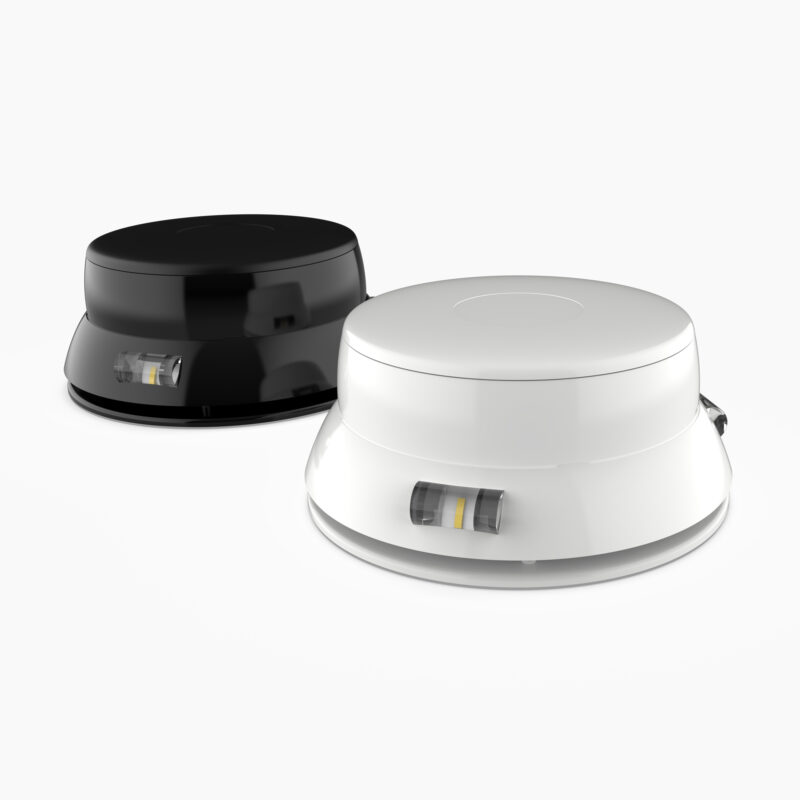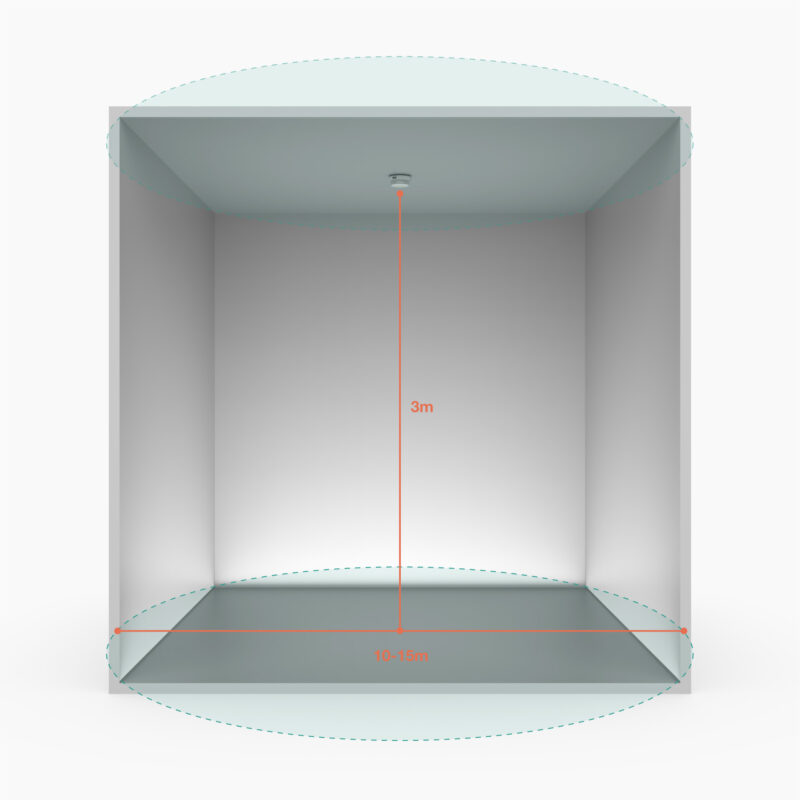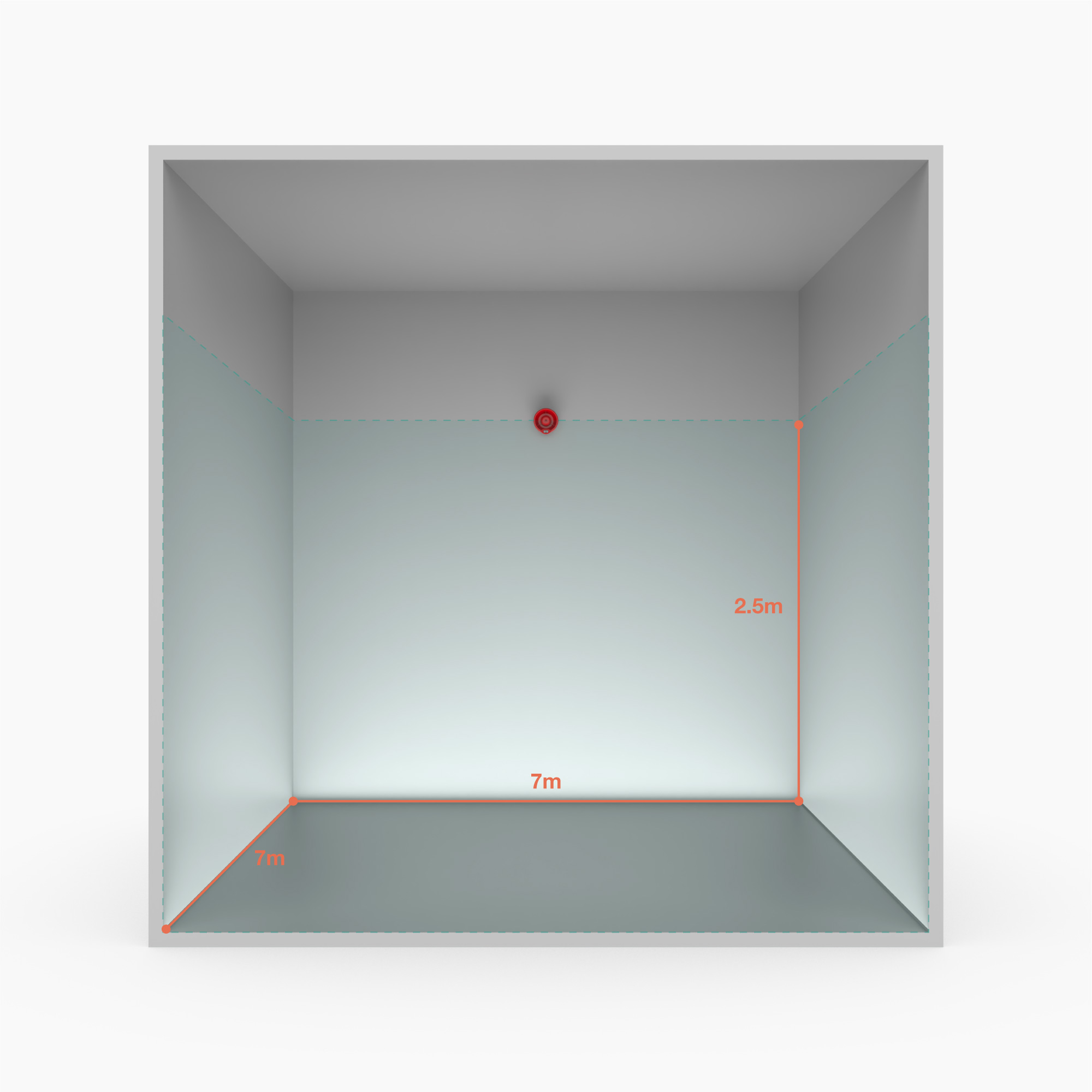Introduction
A Visual Alarm Device (VAD) is a signalling device designed for people with hearing impairments or in environments with high noise levels. VADs use flashing lights or strobes to indicate the presence of a fire alarm, providing an alternative to audible alerts.
VADs cover three Visual Alarm Device categories “wall”, “ceiling” and “open” and in locations where they are considered to be the primary source of warning to building occupants, they must comply with BS EN54-23.
EN54-23
EN54-23 is a European standard that specifies requirements and testing procedures for Visual Alarm Devices (VADs). It defines the performance characteristics of VADs in terms of their light output, flash rate, flash colour and coverage area, ensuring that they meet the needs of people with hearing impairments or in high ambient noise environments.
The Installation Category is a relatively new classification that relates to the shape of the illuminated area produced by a VAD. This shape is determined by the type of mounting surface on which the VAD is installed. The three installation categories are:
- Ceiling mounted – Category C
- Wall mounted – Category W
- Open class – Category O
Other design considerations when using VADs include: the size of the room; ambient light levels; direct or indirect viewing of the device; usage and occupation and environmental conditions.
Typical Applications
- Hearing Impairments
- VADs should be used to provide visual alerts to individuals who may have hearing impairments or are unable to hear the audible alarm due to ambient noise levels.
- Industrial settings
- In factories and other industrial settings with high levels of noise (exceeding 85dB), VADs should be used to alert workers to potential hazards or emergency situations, where audible alarms may not be effective.
- Healthcare facilities
- Hospitals and other healthcare facilities often use VADs to alert patients and staff of emergency situations, without causing unnecessary alarm or distress to patients.
- Educational settings
- In schools and universities, VADs can be used to alert students and staff of fires where audible alarms may not be effective or could cause panic.
- Public buildings
- VADs should be used in public buildings such as libraries, museums and government buildings, to ensure that everyone is alerted to emergency situations, regardless of their hearing ability.
The Limitations when Installing VADs
A typical addressable fire alarm loop provides around 500mA of power. Due to limitations created by the EN54-23 requirements, VADs draw a lot of current when in alarm state. Addressable fire alarm loops can serve a number of input and output devices such as smoke and heat detectors, manual call points, sounders and interface modules. When VADs are required it, therefore, limits the number of devices that can be used on a single loop. It is the fire alarm designers responsibility to ensure that the power consumption of an addressable loop is not overloaded and, consequently, must install additional fire alarm loops, which adds to the installation and supply costs.
The Solution
Wi-Fyre Xenos is a revolutionary wireless fire detection solution from Eurofyre. Xenos systems can be installed extremely quickly and the wireless infrastructure required for the system to operate efficiently can be predetermined by conducting a Xenos system survey. This means that large fire detection systems can be installed incredibly quickly.
Wi-Fyre Xenos fire systems can be programmed, configured and tested away from the property to reduce installation time. This enables precise planning for equipment requirements and minimises the impact on the day-to-day operation of the building. It also helps to guarantee the cost of the installation.
Wi-Fyre Xenos wireless fire detection systems are fully certified to the relevant EN54 standards and offer the highest performing range of fire sensing and notification.
Using Wi-Fyre Xenos, wireless VADs can be installed with little impact on the power consumption of a loop.
Xenos delivers maximum performance with minimum environmental impact. Robust electrical design means Xenos’ battery management is among the best available, with 10 year battery life for sensors, call points and inputs and up to 5 years for outputs, sounders and VADs. Therefore, using Wi-Fyre Xenos, wireless VADs can be installed with little impact on the power consumption of a loop.
System Compatibility & Design
The Wi-Fyre Xenos Wireless Translator module is the main component of the Wi-Fyre Xenos intelligent hybrid fire detection and alarm system. When connected to a compatible loop, the Xenos translator module can wirelessly link up to 128 fully intelligent wireless field devices to the fire alarm system.
Wi-Fyre Xenos Wireless Conventional Translator
The Wi-Fyre Xenos Wireless Conventional Translator can communicate with most conventional and addressable fire alarm systems on the market. It has been designed to be electrically compatible with most modern diode and non-diode based conventional panels and field devices, whilst at the same time allowing wireless field devices to share the fault monitoring capabilities of the conventional control panel.
In addressable mode, the host addressable fire system is required to have a compatible conventional zone monitor unit and/or sounder circuit controller available, together with a local battery backed and monitored power source.
Wi-Fyre Xenos Wireless Translator
When connected directly to the loop or zone wiring of an Argus Vegas addressable fire alarm system, the transponder will act as a seamless analogue-addressable gateway, enabling data and control to take place directly between the panel and individual wireless field devices, with wireless field devices behaving and appearing just like hard-wired devices. In this mode, power is taken from the loop itself and there is no need for a local power supply.
Scalable System Design
Each Wi-Fyre Xenos Translator Module can manage up to 128 Xenos wireless devices. The module creates a unique wireless infrastructure and handles communication protocols with the fire alarm control panel. To extend the network range and improve its stability, Xenos Expander Modules can be used, allowing for an additional 1km range per module.
Wireless Range
The point-to-point transmission range for Xenos is over 1km in open air and its antenna technology is tuned for performance across frequencies and environments. Combined with up to 8 expansion hops a Wi-Fyre Xenos system can cover well over 8km.
Wi-Fyre Xenos Visual Alarm Device Range
There are currently two Visual Alarm Devices in the Wi-Fyre Xenos range:
Wi-Fyre Xenos Wireless Sounder VAD Base with Cap

Key Features
- Bi-directional wireless communications
- Dual channel redundancy
- White blanking cap options
- Red or white flash variants available
- 5 year product warranty

Overview
Xenos Wireless Sounder VAD bases incorporate an EN54-23 compliant visual alarm device (VAD) to alert people in the event of a fire. A sounder cap can be fitted if a detector is not required.
These bases have 32 recognised sounder tones and 4 levels of volume adjustment along with high power/low power visual settings.
Wi-Fyre Xenos Wireless Sounder VAD bases are available with either red or white flashers.
Wi-Fyre Xenos Wireless Wall Sounder VAD

Key Features
- 32 tone settings
- High sound output capability
- Bi-directional wireless communication
- Waterproof certified to IPX5
- 3rd party approval to EN54-3 (Type B)

Overview
Xenos Wall Sounder VADs are EN54-3 (Type B) and EN 54-23 compliant visual/alarm devices with 3-levels of volume adjustment, high output LED beacon and 32 recognised tones.
When connected to a wireless system on a compatible loop, Wi-Fyre Xenos Wireless Wall Sounder VADs are controlled by the panel and benefit from a complete range of intelligent control, testing and monitoring functionality; including sounder synchronisation.
Why Choose Eurofyre?
- Wi-Fyre Xenos Support
- Eurofyre’s team of fire detection specialists are experts in wireless fire detection. We offer a Xenos Survey Kit to buy or hire to make conducting a Wi-Fyre Xenos site survey quick and easy. We also provide Xenos programming support to help with off-site programming.
- Complete System Supplier
- Eurofyre is a complete system supplier which means we can offer expert advice and supply all aspects of fire detection.
- Demonstration and Training
- We have a sophisticated training facility where we offer demonstrations and expert training on a range of systems, including Wi-Fyre Xenos wireless detection systems.
- After-Sales Support
- Eurofyre prides itself on providing after-sales care and support that is second to none. We offer both on-site and telephone assistance to help you ensure that your system is fully operational and working at its best.
For more information about Wi-Fyre Xenos, or to discuss any of the other products that Eurofyre have to offer, please feel free to get in touch either by phone on +44 (0) 1329 835 024, by email to [email protected] or via the online enquiry form situated on our contact page.
Don’t forget you can follow us on LinkedIn, Twitter and Facebook or sign up to our newsletter (in the footer below) to receive all the latest information from Eurofyre.